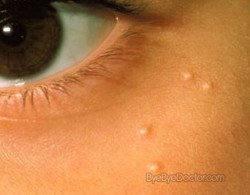The Facts Behind Those Little White Bumps: Milia
March 18, 2013 9:45 pmQuite a few clients have been coming in lately with milia, so I thought we might have a little discussion about what these little white bumps are and how best to deal with them.
What Are Milia?
Milia are small, round, white cyst “pockets” directly under the top layer of your epidermis forming mainly on the face, but occasionally on the neck, scalp, chest, back or back of the hands. They look like little hard grains of sand, occasionally with a blackhead like opening on the surface. When a person has a number of them, the skin can take on an unattractive, ruddy appearance.
The main form of milia is known as primary milia. In this form, the outermost layer of skin is unable to properly shed its dead skin cells and instead the cells get trapped and clog oil-producing pores. Contratry to popular belief, milia are not formed inside a follicle or pore; basically they are just a pocket of normal skin that has sealed over and trapped dead skin cells and then hardened. The contents of each milia are composed of these hardened dead skin cells and resembles a white, sand-like pearl.
Burns and Blisters
Another form of milia, called secondary milia, occur when blistering of the skin actually damages the skin’s ducts. This also results in dead skin cells getting trapped and when enough dead cells are present, the tiny sand sized bumps will appear. Sun burns or rashes from poison oak/ivy can can be the culprit in this case. Sun damage can also be a major contributor to milia, because it thickens and toughens the outermost layers of skin, making it harder for dead skin cells to find their way out of glands. The cysts then form in the areas that were overexposed to harsh rays.
Causes of Milia
It is not yet understood why primary milia appear or why some people get them while others do not. This is mainly due to the fact that research into milia hasn’t received the same amount of attention as other disorders due to its relatively benign nature. They appear to be unrelated to different lifestyles and are certainly not infectious or caused by poor hygiene. So while their exact cause is unknown they have sometimes been related to a diet high in cholesterol or excessive Vitamin C intake. It is also reported that the use of heavy moisturizers or eye creams (heavy for that particular skin type) can be attributed to their appearance.
So What Can Be Done?
Nothing in particular will prevent the base cause of milia, but regular gentle exfoliation of dead skin cells can help keep them from forming. Additionally, regular visits to your skincare professional for extractions, microdermabrasion, and glycolic chemical peels can provide enough cell turn over so that milia are less likely to have the ability to form.
As always, make your diet is in order as well, being sure to include lots of vegetables, fruits, whole grains, and Vitamin A, Steer clear of prepackaged or heavily processed foods. Also, as there may be a cholesterol component to the formation of milia, keep cholesterol-rich foods such as egg yolks and margarine to a minimum (…does anyone eat margarine anymore?).
Here at 360 Skin we help rid clients of milia almost every day. Milia are an easy problem to solve and the Medical Esthetician’s at 360 Skin are here to help correct your skincare problems and educate you on how best to keep your skin looking and feeling its best.
Like us on Facebook: http://www.facebook.com/360Skin
Follow us on Twitter: http://www.twitter.com/360skin
